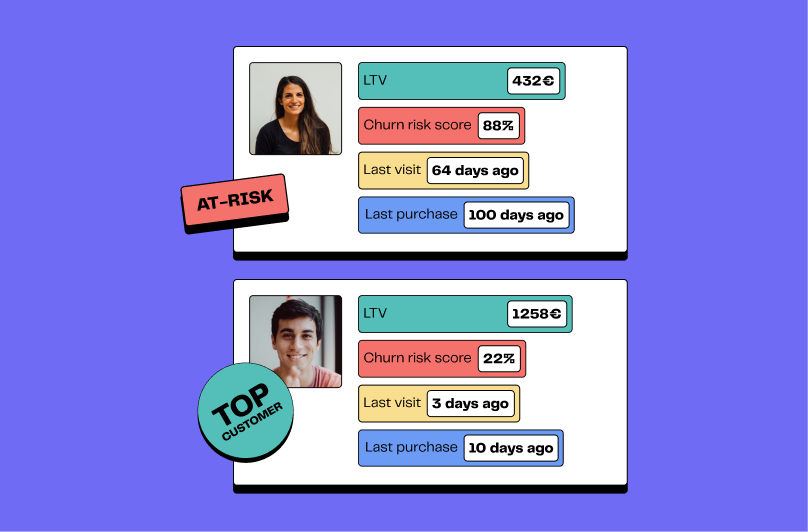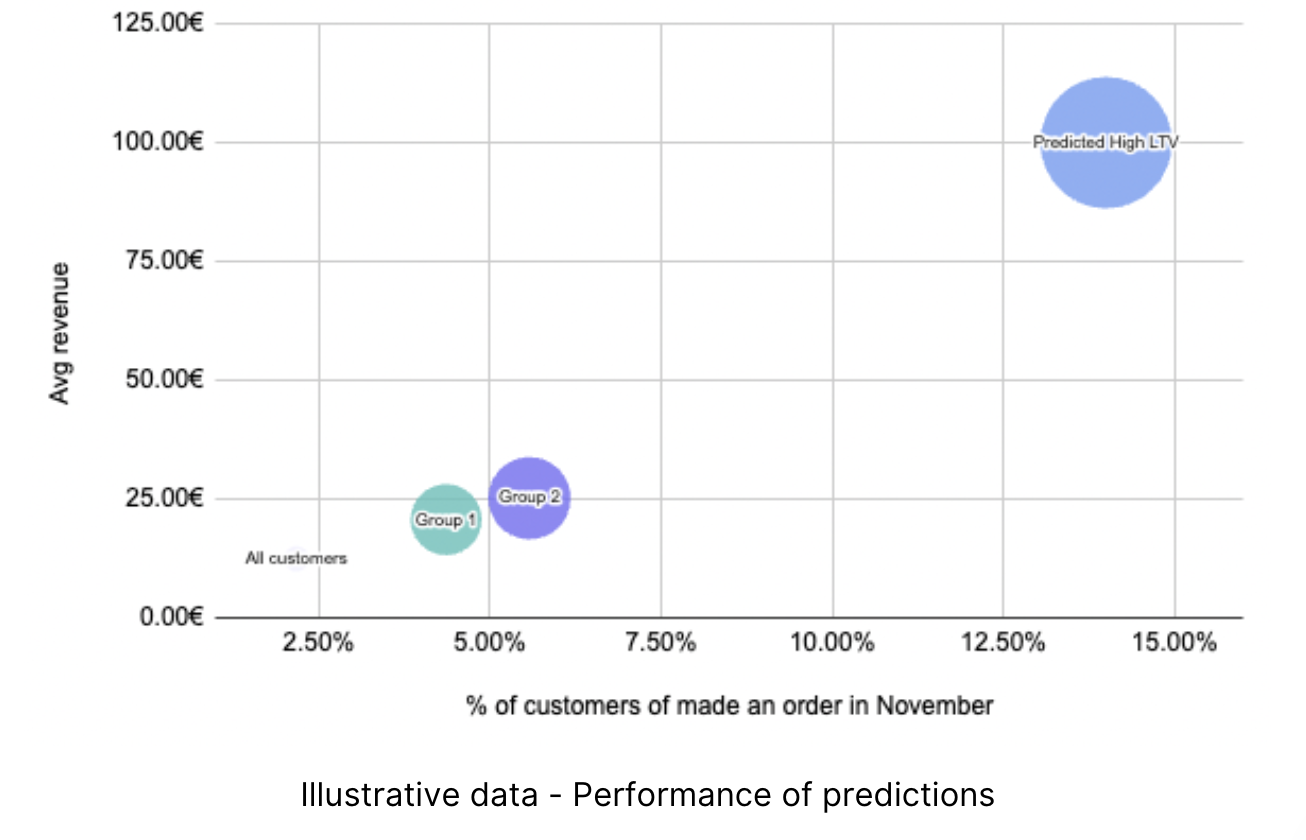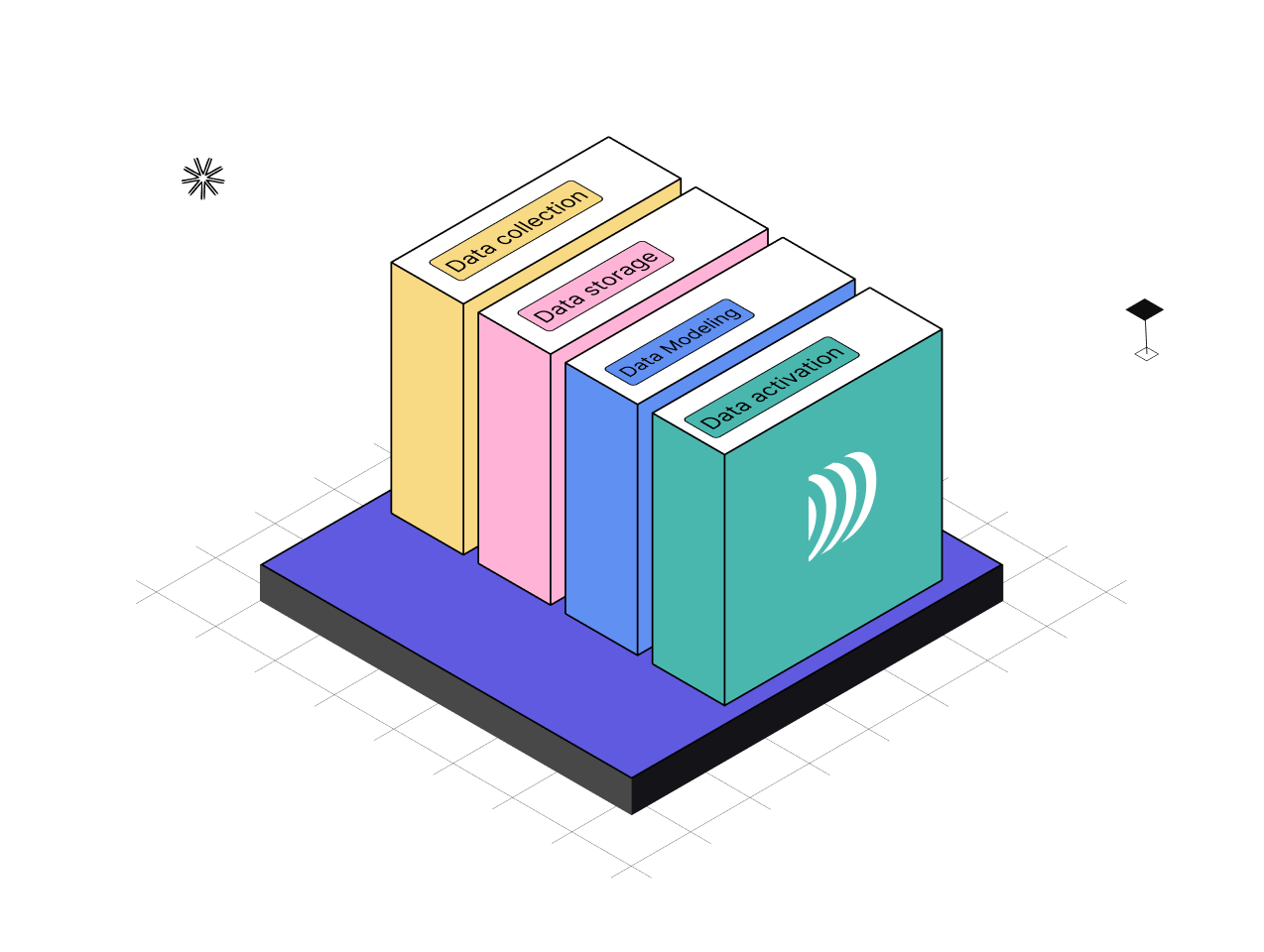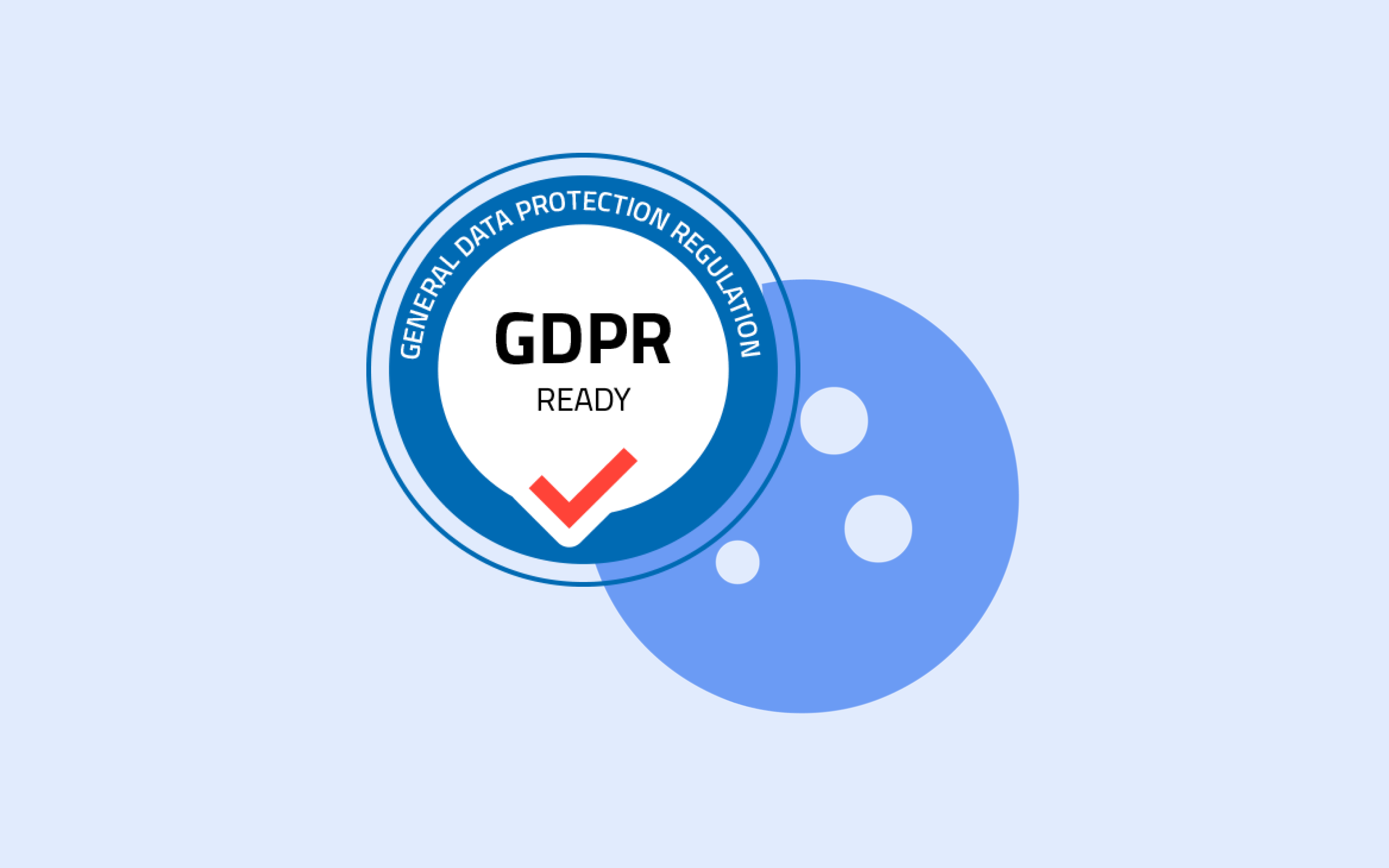
Calculating and improving Customer Lifetime Value (CLV)
5min • Last updated on Mar 31, 2025

Alexandra Augusti
Chief of Staff
The importance of customer lifetime value (CLV, or LTV) cannot be underestimated in today's business environment. Nurturing and enhancing the value of existing customers is more cost-effective than acquiring new ones. Therefore, it is crucial for companies to implement effective strategies to reduce churn, promote loyalty, and maximise the lifetime value of their customers.
Key takeaways:
Customer Lifetime Value measures the total value a customer generates for a business over their entire relationship. A high LTV indicates better long-term profitability.
A Customer Data Platform (CDP) helps optimise CLV by unifying customer data, enhancing segmentation, and personalising marketing interactions.
The main levers to improve CLV include campaign personalisation, optimising customer journeys, and anticipating churn.
Leveraging first-party data with a CDP improves marketing ROI. This approach boosts customer loyalty and maximises the value of existing customers.
👉🏼 Let's take a moment to detail all strategies that can be implemented to increase CLV, a key CDP use case.
Understanding Customer Lifetime Value
Customer Lifetime Value represents the net revenue a customer contributes to a business over their entire relationship. Maximising CLV is essential to ensure profitability and, more importantly, business growth.
For relevance, CLV should be compared to associated costs of maintaining the customer. This includes the cost of customer acquisition (CAC), customer service costs, marketing and sales expenses, and customer relationship management costs. By understanding these elements, you can assess profitability and identify optimisation opportunities.
One advantage of CLV is that it accounts for customer loyalty, their propensity to purchase more products or services over time, and their likelihood of remaining a customer in the long term.
A key to maximising customer lifetime value is providing a highly personalised customer experience. By offering quality customer service, anticipating customer needs and concerns, and providing high-quality products or services, you can foster customer loyalty and encourage them to make more purchases. Investing in customer relationships can increase your clients' CLV and ensure business growth.
Calculating CLV
Calculating CLV is straightforward but requires certain information about your customers:
Average order value
Purchase frequency
Average customer lifespan*
The CLV formula, therefore, is the multiplication of the average order value by the purchase frequency and the average customer lifespan.
*The average lifespan of a customer is a crucial component of the CLV calculation. Here are some common methods to estimate it:
Cohort Analysis: This method involves grouping customers into cohorts based on their acquisition date. These cohorts are then tracked to see how long customers remain active before disengaging.
Survival Models: These models treat customer churn as an "event" and analyse the time until this event occurs, considering various explanatory variables.
Retention Rate Calculation: A more straightforward approach is to use the annual retention rate to estimate the average lifespan. For example, if the retention rate is 80%, the average lifespan can be roughly estimated as 1/(1 - 0.80) = 5 years. This method is simple yet effective for a quick estimate.
⚠️ If you sell products and/or services for which these indicators vary greatly, it is relevant to calculate an LTV per segment.
💡 LTV can also be expressed in terms of margin, in which case simply use margin instead of sales for all financial data.
Strategies to maximise Lifetime Value
Personalising the customer experience
One of the most effective strategies to maximise the lifetime value of customers is to personalise their experience as much as possible. By understanding your customers' needs, preferences, and behaviours, you can offer tailored promotions and services. Personalising the customer experience can involve product recommendations based on purchase history or customising marketing communications.
Loyalty programmes and rewards
Implementing a loyalty programme and rewards can be another effective strategy to maximise customer lifetime value. By rewarding repeated purchases, referrals, or participation in special events, you can encourage customers to remain loyal to your brand and increase their average order value.
Proactive communication and customer engagement
Proactive communication and regular customer engagement are essential to maximise customer lifetime value. By staying in touch with your customers, offering updates on your products or services, soliciting their feedback, and addressing their queries, you can strengthen customer relationships and enhance their satisfaction.
Optimising the shopping experience
Enhancing the shopping experience is another key lever to maximise customer lifetime value. Think omnichannel! The experience should be seamless and unified, whether online or offline.
By simplifying the buying process, offering flexible payment options, providing satisfaction guarantees, or facilitating returns and exchanges, you can improve customer satisfaction and encourage repeated purchases. The shopping experience should be smooth, intuitive, and enjoyable to encourage customers to return and recommend your brand to others.
The emergence of AI in optimising CLV
Artificial intelligence (AI) has become an indispensable tool for businesses looking to improve their processes and provide ultra-personalised, optimised customer experiences.
AI is your new ally if you want to maximise the CLV of your customers.
Enhancing personalisation through AI
AI can be used to analyse customer data and generate customised recommendations based on buying preferences and behaviours. By employing machine learning algorithms, companies can create unique customer experiences tailored to each individual. Recommendations are generally more precise when generated by predictive AI.
Optimising marketing campaigns with AI
Machine learning (ML) can also be used to optimise marketing campaigns by identifying the most profitable customer segments and tailoring messages accordingly.
AI is used for various tasks in digital marketing, regardless of the targeted stage in the customer lifecycle. AI helps to reduce customer acquisition costs (CAC), increase purchasing periods, and average revenue, especially by:
Defining the Target Audience: To maximise a customer's lifetime value, it's essential to address them at the right time with the right message, considering their stage in the lifecycle. Segmenting your customer base is therefore crucial for effectively targeting your audience. AI can assist in finding relevant segments.
💡 At DinMo, we complement the customer view with predictive indicators (retention, expected additional CLV, etc.), which can be used for segmentation. To find out more, read our Galeries Lafayette case study.

DinMo predictive models
Using audience signals: By using advanced analytics tools and AI, you can collect, analyse, and interpret audience signals to make strategic decisions based on reliable data. Understanding your customers' needs and expectations allows you to personalise their experience, anticipate their future needs, and strengthen their engagement with your brand.
Optimising algorithms: Advertising giants (Google, Meta etc) obviously use AI and machine learning techniques to optimise their algorithms, especially in cases of "Smart Bidding." They are increasingly effective at targeting individuals likely to convert, thus optimising outcomes.
⚠️ However, be sure to clearly define the objective of your campaign! For instance, if the goal of a campaign is to generate leads, the algorithm is optimised to maximise form submissions. However, the quality of the lead is not guaranteed!
Content writing and asset optimisation: A well-organised campaign structure and attractive creative assets can enhance the effectiveness of your campaigns and increase the lifetime value of your customers. And for this, AI is your best ally! By combining a solid campaign structure with high-quality creative assets, you can maximise the impact of your marketing campaigns and achieve your goals more easily.
Improving customer experience through AI
AI can also be used to enhance the customer experience by providing quick and personalised responses to client inquiries. AI-powered chatbots can address customer requests in real-time, improving customer satisfaction and reducing wait times. By employing chatbots to handle customer interactions, businesses can offer 24/7 customer service and enhance the quality of the customer experience.
What KPIs to track to ensure strategy effectiveness?
To evaluate the effectiveness of strategies aimed at improving a customer's lifetime value, it is important to monitor specific KPIs. Here are some key indicators:
CLV: Comparing CLV across different time periods allows you to monitor the outcomes.
Customer Acquisition Cost (CAC): It's important to regularly compare CAC to CLV to ensure that the cost of acquiring a customer remains economically justifiable relative to the value they bring.
Retention Rate: A crucial KPI that measures the percentage of customers who remain active over a given period compared to an earlier period. An increase in retention rate often indicates an improvement in CLV.
Purchase Frequency: Measuring how often customers return to make purchases helps assess the effectiveness of re-engagement and loyalty strategies.
Average Order Value (AOV): Tracking whether the transaction value per customer is increasing can indicate an increase in CLV due to greater spending per visit.
NPS (Net Promoter Score): This score helps measure customer satisfaction and loyalty. A high NPS is often a good predictor of high CLV, as satisfied customers tend to spend more and stay longer.
Regularly tracking these measures can provide valuable insights into the effectiveness of initiatives taken to maximise customer CLV. They also allow for continuous adjustment of strategies based on the outcomes to optimise return on investment continuously.
Conclusion
In conclusion, Customer Lifetime Value (CLV) is an essential indicator that not only measures a customer's financial contribution over time but also serves as a guide for directing marketing and customer service strategies. By adopting a methodical approach to calculating and maximising CLV, including sophisticated data analysis and strategic use of artificial intelligence, businesses can strengthen customer loyalty, optimise acquisition spending, and ultimately increase profitability.
A Customer Data Platform can help you every step of the way!
If you need assistance reducing your acquisition costs and optimising your CLV through the activation of your customer data, do not hesitate to contact us.
















